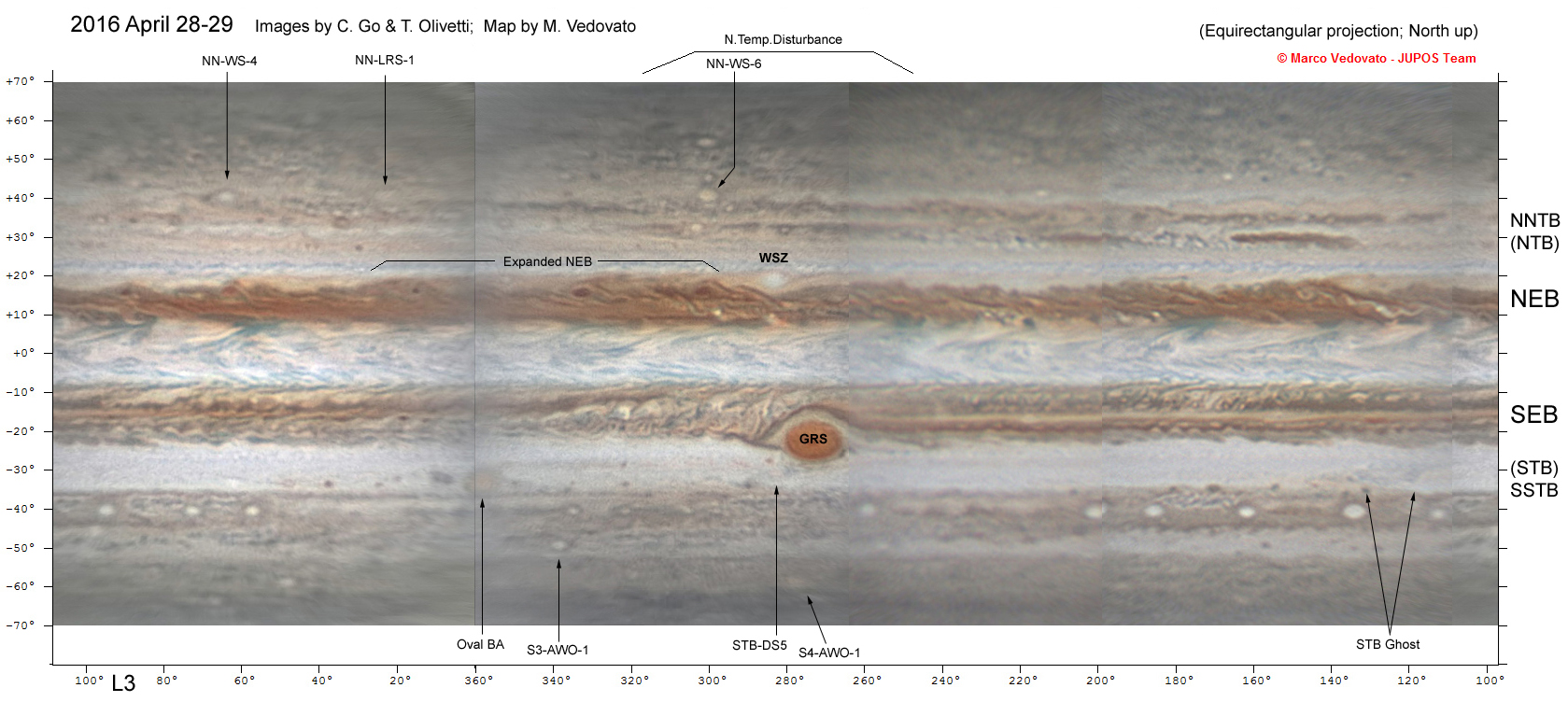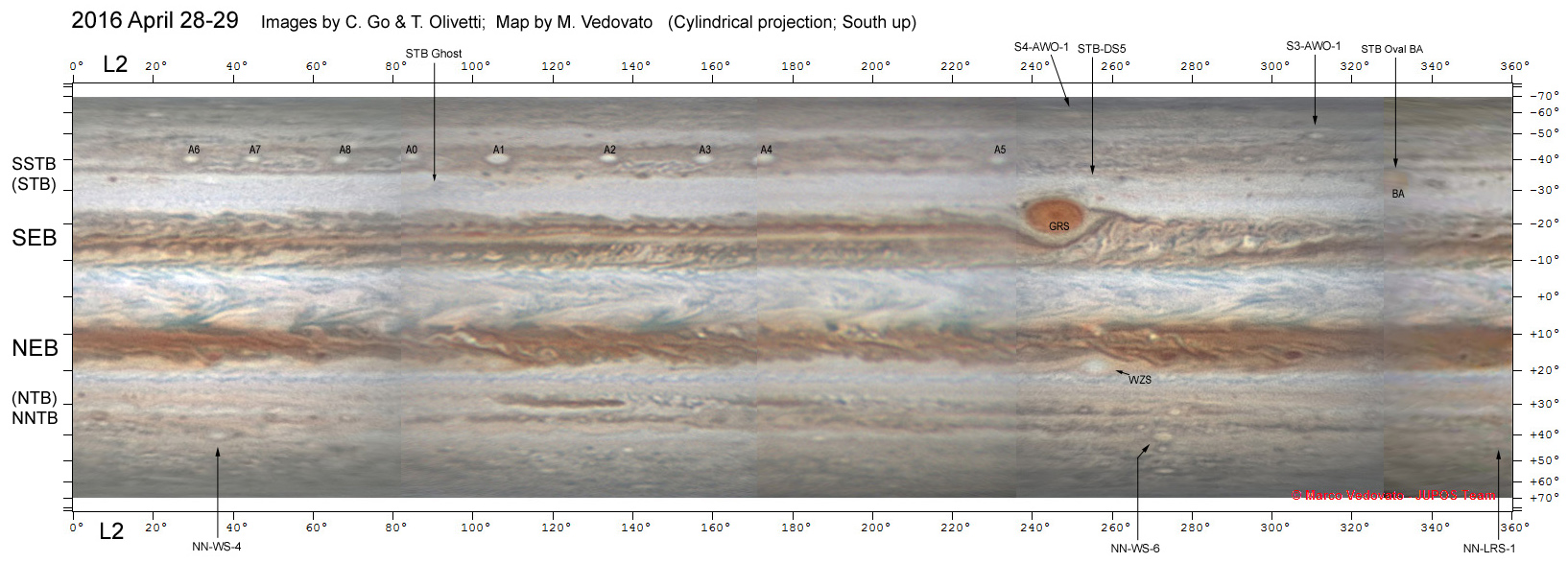2015/16, Report No.8: A brief interim report.
2015/16, Report No.8: A brief interim report.
–John Rogers (BAA), 2016 May 6
This is a summary of the state of Jupiter’s atmosphere as of early May, 2016. It follows on from our 2015/16 Report no.3. All the information is due to the numerous observers who have sent images, and to the JUPOS team for their charts. Special thanks go to Christopher Go and Tiziano Olivetti, who have maintained regular coverage at the very highest resolution. Their images on April 28-29 were used by Marco Vedovato to make the latest map, which is attached herewith, with key features labelled. It is shown both in System II (south up) and in System III (north up).
N.N. Temperate (N2) domain:
The three long-lived anticyclonic ovals are still present. LRS-1 is virtually invisible, but still notably methane-bright. WS-6 appears creamy white, and more weakly methane-bright. WS-4 is white, but barely detectable in methane images.
N. Temperate (N1) domain:
The N. Temperate Disturbance is still present and still changing its boundaries. It now follows two rifted sectors of NTB, which are flanked by dark streaks of NTB(N). NTB(S) is still very pale.
N. Tropical domain:
The NEB expansion event has stalled and is now regressing, having only covered 140º longitude! Having reached this length in Jan., the expanded NEBn did not proceed further, and in Feb. it began to fade both at its p. end (around white spot Z) and at its f. end (around NRS-2). It is now only 90º long, and NRS-1 and -2 have disappeared. Conversely, barges have continued to appear; there are now five of them (between L2 ~ 270-60, L3 ~ 300-90).
White spot Z is still the only AWO, a bright white oval embedded in yellowish surroundings. It is moving unusually slowly: DL2 = -6.0 deg/month during this apparition. Exceptionally, its core is now dark in methane images.
The methane-dark waves are still present over much of the expanded sector of NEB and f. it (L2 ~ 300-70, L3 ~ 320-90), but they are no longer present around its p. end (as shown in Chris Go’s methane-band images).
There is less rifting within the NEB now.
On the NEBs edge, there are still major dark formations, with positive DL1, all around the planet.
S. Tropical domain:
The rifted region of SEB f. the GRS has been extended by new outbreaks of white spots at its f. end: one at L2 = 294 on March 1 (as shown in Report no.5), and another at L2 = 313 on March 26 (first imaged by A. Lasala). The latter was methane-bright on March 28 (C. Go) and 29 (M. Kardasis). So the rifted region is now longer than before and notably dynamic.
The GRS moved from L2 = 241 on March 1 to 245 on April 15, a large positive drift, but this may be merely a large swing of the 90-day oscillation.
The best images continue to show a rather consistent pattern of mottlings within the GRS. On several dates, it has again been possible to visualise the internal circulation of the GRS from images taken over 1-2 hours as it crosses Jupiter’s disk. This was achieved using images by C. Go and T. Olivetti on March 5 (see our Report no.6) and March 10 and 12 (new compilations now added to Report no.6):
https://britastro.org/node/7228. (All maps were made by M. Jacquesson.) It was also achieved by Kevin Quin on April 6; his beautiful animated map is posted at:
https://www.youtube.com/watch?v=KC33uLL3avU
S. Temperate (S1) domain:
The STB is completely absent, as there is no substantial activity on the STB(N), and all three structured sectors are faint. They are as follows:
(1) Oval BA and the small dark spot f. it. The dark spot was still disturbed in Feb., emitting some dark spots Sf. it and dark material on STB(N) p. it; but in March it at last quietened down and it is now very small. With the decline of this activity, oval BA has been slow-moving with DL2 = -10.5 (±0.3) deg/month from mid-Jan. to mid-March, and possibly even slower now.
(2) The STB Ghost. A volley of SSTBn jet spots has approached it in late April, so images coming in now will be examined for signs of recirculation.
(3) DS5, which I propose to call the STB Spectre if it survives. The original dark spot has faded to light pink – still within its pale blue shroud — and is now passing the GRS.
S.S. Temperate (S2) domain:
The nine major AWOs are unchanged. The whitened cyclonic sector between A4 and A5 has lengthened further, now 40º long, though it is now light grey rather than white.
S3 and S4 domains:
S3-AWO-1 (at ~50ºS), and two AWOs at ~60ºS, are white ovals with oscillating tracks. S4-AWO-1, the long-lived reddish oval at ~60ºS, is now stationary at L2 = 250 (due S of the GRS).
_______________________________


| The British Astronomical Association supports amateur astronomers around the UK and the rest of the world. Find out more about the BAA or join us. |
